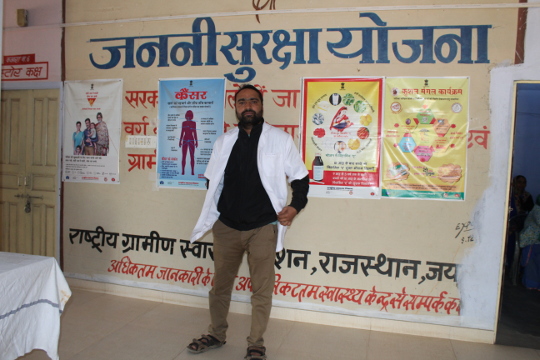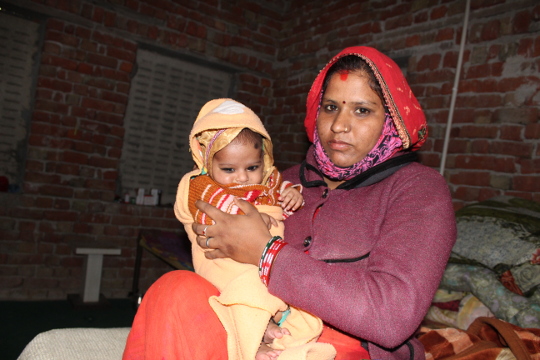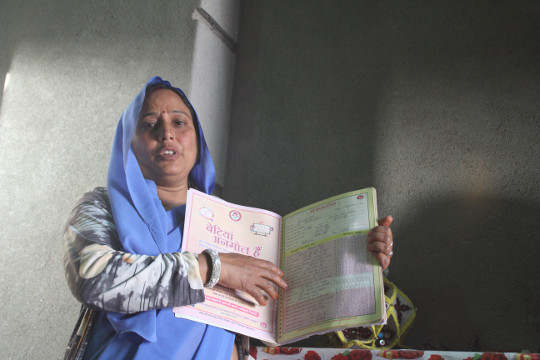Ravindra Kumar Saini throws up his hands in the air and says, “How can I ever get people to trust me?” Saini is the doctor in charge of the Primary Health Centre at the village of Niwana in Govindpur block (district Jaipur). In the last 15 days, he has been to the centre just three times as he has too many other duties to perform. On the other days he was marking his presence at health camps, meetings, video conferences or giving evidence in court in his official capacity.
Ravindra Kumar Saini, the doctor in charge of the PHC at Niwana. Pic: Puja Awasthi
A PHC such as the one Saini manages is the first point of contact between the people of a village and a government health officer. Hence its importance can hardly be overemphasized. This one is clean, well-maintained and ticks all the equipment checklist. It has recently been upgraded to the status of a Health and Wellness Centre as part of the Ayushman Bharat programme. Among other things that upgrade means such centres will also have an ayurvedic practitioner (yet to be appointed at Niwana). But in the frequent absence of the doctor, the centre remains deserted even on those rare days when he makes an appearance.
This erratic attendance is just one of the many reasons that corrode trust in the government health care system. In a state like Rajasthan, which anyway ranks poorly on health indicators, such cynicism compounds the problems of its sick, especially women whose health needs are often accorded lowest priority.
According to a study conducted in 2018 by the Participatory Research in Asia (PRIA)—a global centre for research and training, the deficient status of public health care imposes a huge financial burden. The survey covered 520 pregnant and lactating women in two blocks of Rajasthan (Banswara and Govindgarh) to conclude that families spend anywhere between Rs 20,000 to Rs 30,000 on delivery and a further Rs 5,000 to Rs 6,000 on ante-natal care (ANC). For poor families, this means a deeper push into poverty.
Sanjana Devi Kumawat, a 24-year-old first time mother in another village of the district Sigod Khurd (tehsil Chomu) provides the illustration to these distressing numbers. Throughout the duration of her pregnancy, Kumawat had been a regular at the PHC to get the requisite check-ups and supplements. But when nine months were over and she felt no pain, she was referred to the district hospital at Chomu. “The hospital was very dirty. The doctor said I might need an operation but that he would see what could be done only in the evening. The other option he gave me was to go to Jaipur. It was just my husband and me. We thought either I or the baby could die while waiting. “We panicked,” she says.
Sanjana Kumawat with her two-month-old son Mayank. Pic: Puja Awasthi
Kumawat recalls that on the particular date the couple visited the hospital, it was a holiday of some kind and there were hardly any health personnel around. Instead of making the one-hour journey to the government hospital in Jaipur on a motorcycle, she and her husband Suresh decided that they would go to a privately-owned hospital in Chomu. Even if it had not been a situation of panic, Kumawat could have ended up in a private facility. This observation is drawn from a study of 898 women in Govindgarh, conducted by PRIA in March 2018 which notes that more than one-fourth of the surveyed women preferred private hospitals for deliveries.
For the operation and the subsequent one week stay, and the following festivities to celebrate the birth, Suresh borrowed Rs 60,000 from the neighbours. “We have to pay Rs 2 for every Rs 100 taken. My husband does not tell me the exact sum he has paid back but it is very meagre,” Kumawat despairs.
The loan will eat into the land less couple’s financial bearings. Suresh who works as a tiler in buildings, earns Rs 10,00 a month- just one sixth of his current debt.
Pushplata Verma has been working as the Asha Sahyogini at Singod since 2008. Such functionaries make door to door visits to ensure the community, especially expectant mothers, adolescent girls and infants avail of the health services offered at the village level. Throughout Kumawat’s pregnancy, Verma had checked on her and since the birth of her son she has been around every week to measure the newborn's weight.
“We try our best. But then there are things beyond us,” Verma says.
Pushplata Verma shows the diary she maintains as part of her work. Pic: Puja Awasthi
In Kumawat’s case for instance the financial pressure was compounded by the fact that her name was missing from the family’s Bhamashah card. This card issued under a state government scheme since 2008 provides cash and non-cash benefits under various public welfare schemes. Had Kumawat’s name been on the card, she would have been eligible for all the expenses incurred during hospitalisation (provided the hospital she went to was part of the network).

Over the last five years an intervention dubbed Apna Swasthya, Apni Pehel (Our Health, Our Initiative) by PRIA has been trying to make the community demand its health rights by greater participation in local governance. As part of this approach the community (especially women) is being nudged to a greater participation in the Gram Sabha to especially press the Gram Panchayats (GP) to include proposals for women’s health in their yearly development plan. The last is crucial given that till June 2017, no GP in the block had undertaken any health planning despite the state government’s guidelines to the effect issued in June 2016.
“There has been a slow change. Women are getting more confident,” says Verma. She adds that through its frequent visits the organisation has earned the trust of the villagers. “I have support. Earlier I was hesitant to talk to the men. Now they help me to do that. Having a third party reinforce the messages that I am giving to the community makes us stronger,” she says.
This demand of its rights by a community is likely to be the key driver in effecting sustainable change in Govindgarh.


























